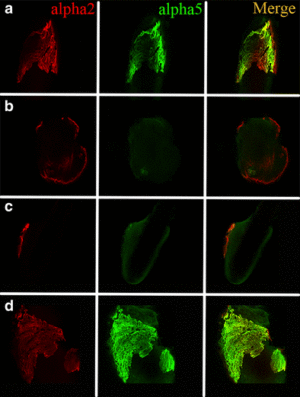
Andrew Malone
A novel method to diagnose X-linked Alport Syndrome has been developed and validated in a recent study by Andrew Malone, MBBCh, Steven Funk, PhD, Tarek Alhamad, MD and Jeffrey Miner, PhD, in the Division of Nephrology.
Alport syndrome is an inherited disease characterized by a progressive loss of kidney function, hearing loss and eye abnormalities, and is caused by genetic mutations affecting the type IV collagen family of proteins in basement membranes.

Tarek Alhamad
X-linked Alport Syndrome accounts for 80% to 85% of the cases and results from mutations of the collagen α5(IV) protein (COL4A5 gene). Diagnosis is generally made by looking for morphological changes or the presence or absence of α5(IV) protein in skin or kidney biopsies. Genetic testing can also be performed when available.
 Because the epidermal basement membrane is continuous with the hair follicle basement membrane, a normal hair follicle should retain part of the basement membrane from the skin from which it was “plucked”. Since patients with X-linked Alport Syndrome exhibit abnormal staining of the α5(IV) protein in the skin, the group reasoned that analysis of this protein in plucked hair follicles could be a simple, non-invasive method to screen for the disease.
Because the epidermal basement membrane is continuous with the hair follicle basement membrane, a normal hair follicle should retain part of the basement membrane from the skin from which it was “plucked”. Since patients with X-linked Alport Syndrome exhibit abnormal staining of the α5(IV) protein in the skin, the group reasoned that analysis of this protein in plucked hair follicles could be a simple, non-invasive method to screen for the disease.
Plucked hairs from controls and members of a family diagnosed with X-linked Alport Syndrome were briefly incubated with fluorochrome-conjugated anti-collagen IV antibodies. The hairs were then whole-mounted for confocal immunofluorescence microscopy of the follicles. Follicles of the affected family members had reduced α5(IV) protein compared to the controls or family members without Alport Syndrome.

Steven Funk
This non-invasive assay was used to study a novel splice region mutation in COL4A5 in an Alport Syndrome affected family. The mutation causes truncation of the collagen α5(IV) protein. They found that the splice region variant is a pathogenic mutation that leads to expression of mostly abnormal transcripts, but also some normal transcripts, which would explain the variable phenotypes seen in the family members carrying the mutation.

Jeffrey Miner
First author Andrew Malone says, “In certain patients, hair follicle testing has the potential to be a useful non-invasive test for Alports that avoids the costs and risks associated with procedures such as kidney and skin biopsy.”
Read full article here.